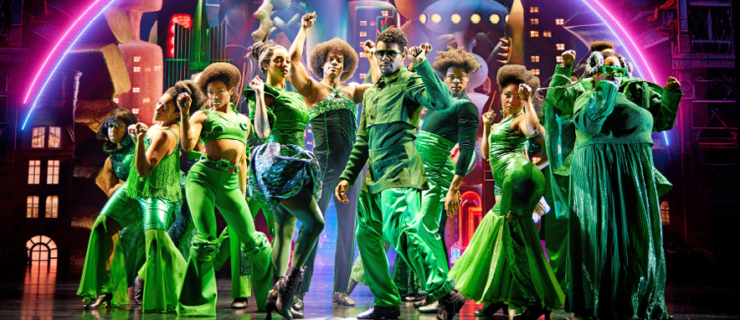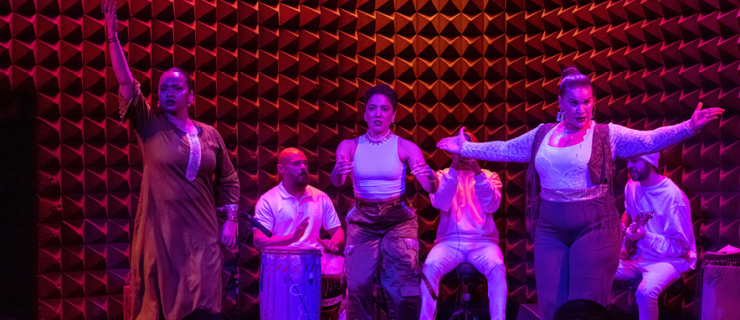LaTasha Barnes: Reclaiming Black Vernacular Dances, One Performance at a Time
Earlier this year, LaTasha Barnes had the rare opportunity to perform in her native Virginia, on tour with Caleb Teicher’s SW!NG OUT. Her family was in the audience, so she decided to pay tribute to her father. “My dad has this really smooth, cool dance he calls ‘The Monster,’ ” she says. “I got to pull it out. I usually don’t hold on to any movement longer than a phrase, but I rocked with this one for a while.”
That moment—which Barnes says was one of the proudest of her life—encapsulates much of what has been at the heart of her dance career: Joyfully embodying the legacy of Black vernacular dance in America, from early jazz dances to steps she learned at family gatherings to house and hip hop.
Barnes not only excels in each of these dances, she also makes visible the connections between them, both historical and physical. In May 2021, Barnes expanded an investigation that was already happening in her own body with The Jazz Continuum, a performance commissioned by Works & Process at the Guggenheim that traces jazz dance and music to their artistic offspring, with a cast of Black dance and musical artists of varied specializations, including jazz, house, hip hop, funk and disco.
“I just wanted more people to play with,” she says of the show, which got a second iteration at Jacob’s Pillow in August 2021 and will be at The Joyce Theater this fall, ahead of its tour. She got much more than people to play with: Barnes, who is 42, was showered in long-overdue acclaim—including a Bessie Award for Sustained Achievement in the Outstanding Performer category and a nod from The New York Times as one the best dance moments of 2021—after years of relative anonymity outside the Lindy Hop and house communities, where she was already legendary.

Some of the press Barnes has received recently has labeled her as just a Lindy Hop dancer, or just a house dancer. It’s something she actively resists, because it is her multiplicity, both in the styles she dances and the roles she plays—dancer, culture bearer, teacher, scholar—that makes her so very singular. “I’m proud that I trusted the universe to make space for all of me,” she says.
Born and raised in Richmond, Virginia, Barnes excelled academically and at a laundry list of after-school activities, including track and field, choir, student leadership and JROTC. “Even before I understood what it meant, my life was always full-tilt, in all the things,” she says.
Her dance training began at home—her father was a deejay, and movement flowed through all of the family’s gatherings and daily activities. One of her earliest memories is of her great-grandmother guiding her through the “run, jump, squat” that she now recognizes as a Lindy Hop step. She also remembers learning the Barnes family line dance—which made its way into an iteration of The Jazz Continuum—and “being fascinated by how my family moved in sync, and how some of them had extra embellishments,” she says. “It wasn’t so much about perfection, just not being a distraction to the overall groove.”
Barnes took several years of dance classes in elementary school, but eventually stopped, her eyes opened by her teacher’s warning that the dance world wouldn’t be welcoming to her. As she puts it, “My formal dance training concluded, but the most rigorous dance training had just begun.” This consisted of swapping moves with her cousins and friends, who brought steps from New York City and Washington, DC, and the roller skating parties Barnes would attend after track meets, parties where, eventually, the skates would come off and everyone would dance.
After high school, Barnes followed in the footsteps of her father, who was an Army First Sergeant, passing on college scholarships for track and engineering to quickly progress to sergeant first class. While stationed in Belgium, Barnes and her best friend became staples in the club scene, so much so that a camera crew filming promotional footage would follow them from club to club.

Back in the States two years later, Barnes was selected for an assignment at the White House. Meanwhile, she was entering fitness competitions, at one point placing second in the National Physique Committee’s Junior Nationals. While practicing a high kick in preparation for one competition, Barnes suffered a tear in her left glute, which necessitated a year of recovery. Then, just as she was getting back into the gym, she was hit by a car and dislocated her hip, injured her low back and fractured her wrist.
It was while in recovery from that set of injuries that Barnes took up formal dance training again, starting with a class that was billed as hip hop but which Barnes immediately recognized as popping. “The popping actually was what I needed to regain mobility and control of my body,” she says. “And it’s also something that I’m now known for within the context of other forms, my ability to use a hit.”
Recognizing Barnes’ gifts, and the “residual boogie” in her body, her teacher introduced her to Junious Brickhouse, a house dancer and founder of the Urban Artistry company, based in the DC area. Barnes began training extensively in house, eventually joining the company’s leadership team—a position that required dancers to be proficient in at least five styles. This prerequisite very much aligned with Barnes’ natural inclinations. “It gave me the tools to organize that facet of myself,” says Barnes, who sought out mentorship in styles like waacking.
In 2011, Barnes and her house partner Toyin Sogunroplaced first at Juste Debout in Paris, one of the biggest battles in the world. “We were almost mobbed at the airport in France, and then we came back to the U.S. and nobody knew anything,” she says. But Barnes knew she was at a turning point—just before leaving for Paris, she’d given notice at her job. “I could feel the universe pulling me back to dancing,” she says. “I felt like I also needed to make some grand gesture to be like ‘I receive it.’ ”

It was around this time that Barnes was becoming more interested in jazz dance—Lindy Hop in particular—and more aware of its origins as a Black art form. She began to feel its connectedness to the other styles she danced. She exchanged movement with Lindy Hop champion Bobby White, for instance, sharing her knowledge of house and other styles and learning about authentic jazz and Lindy Hop. True to form, she caught on quickly. At the International Lindy Hop Championships, which Barnes now co-owns, she won accolades for her dancing. But these experiences also reiterated to Barnes the need to bridge the communities of house and Lindy Hop, “that are so tethered to one another, yet have no awareness of each other,” she says.
Barnes began exploring this in her dancing—she’d throw in a deconstructed jump Charleston during a house battle, and afterwards people would “acknowledge something different in there.” Switching between styles can sometimes look forced, or disjointed, but never with Barnes: The ease with which she layers them on top of one another is masterful, and a powerful illumination of their shared lineage. Michele Byrd-McPhee, founder of Ladies of Hip Hop and a Jazz Continuum cast member, says that before working with Barnes, she “thought of authentic jazz dance as something that was in the past.” Barnes’ work, Byrd-McPhee says, grounds her “in who we are as Black people.”
But investigating the ways that hip hop, house and other Black vernacular dances evolved from the work of early Black jazz dance pioneers left Barnes with questions. Why weren’t Black dancers more aware of or engaged with jazz? Why were jazz and Lindy Hop so disconnected from those other forms that had sprung from it?
As Barnes was becoming a culture bearer in Lindy Hop, paving the way for the form to be reclaimed by Black dancers and accepting the proverbial torch from legends like Norma Miller, she was also digging for the answers to these questions in her self-designed master’s program at New York University’s Gallatin School of Individualized Study. When she realized how few Black dancers outside of Eurocentric dance forms had been cited in existing scholarly resources, she began interviewing them for her thesis, canonizing their experiences as she did so.
“I thought when I started my master’s program it was going to be about figuring out how to bring Blackness back to Lindy Hop and jazz,” she says. “But you can’t make something more Black that was Black already.”
You could see The Jazz Continuum as the ultimate embodied thesis. “People are certainly lecturing about this,” says Melanie George, founder of the Jazz Is… Dance Project and associate curator at Jacob’s Pillow. “But she’s doing it onstage, drawing that line very clearly to say that jazz, funk, hip hop, house—they are all of a family. If there isn’t an embodied aspect of that, we’ve actually broken part of the continuum.”

Barnes is currently on tour with SW!NG OUT, where she is both a performer and a core collaborator, and this month, she’ll teach and rock cyphers at the Ladies of Hip-Hop Fest. In the fall, she will be a guest artist in residence at Point Park University and will return to teaching at Arizona State University, where she’s been on faculty since last year and where she models what it means to be a tradition bearer for her students, says her ASU colleague Dr. Christi Jay Wells. “It’s about responsible stewardship of what she’s been given by her elders, her ancestors and her peers,” Wells says.
Indeed, you’d be hard-pressed to speak to Barnes about dance for more than a minute or so without her naming a mentor or teacher who’s shaped her path, or a jazz forebear who never got their rightful flowers. She vacillates between deflecting praise, careful that her success doesn’t fall into a false narrative of individualism, and proudly accepting it on behalf of herself and her predecessors.
“I’m recognizing that by running away from those moments, I’m not making space for those who came before me who didn’t get the chance to be acknowledged,” she says. “Because I absolutely carry them with me. And so, I have no problem standing in it now.”




